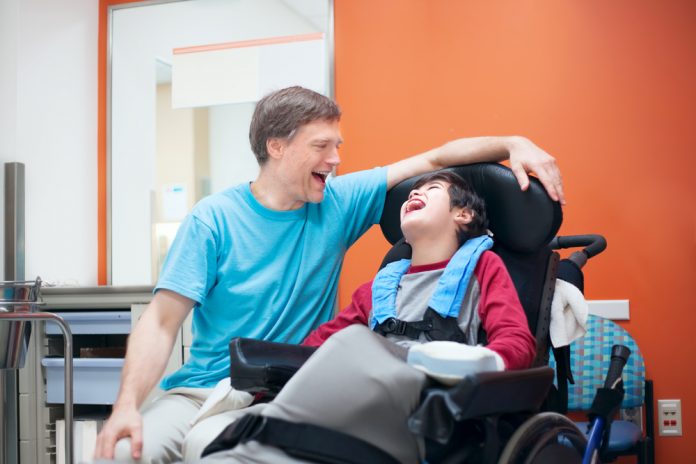

By David and Mercedes Rizzo
Holy Communion is one of the main ways we encounter Jesus. Preparation for First Communion is an important focus of religious education programs. It provides a strong foundation for our participation in the Mass. Parents of children with special needs recognize this and desire that their children encounter the real presence of Christ in the Sacrament. Unfortunately, some parents are fearful that their child with special needs may face difficulty attending a catechism program or being able to receive First Communion.
Children with special needs can succeed in their religious education programs and meet the requirements for receipt of Holy Communion. However, special needs is a broad category encompassing children with a variety of conditions including language difficulties, physical limitations, hearing and visual impairments, medical issues, and learning/behavioral problems. It is quite common that children may experience more than one of the above.
Special needs present unique challenges for directors of religious education, catechists, and families. It’s important that programs be designed to take advantage of student’s strengths and make use of teaching styles and approaches that work well for children with special needs. It is also important to address any problems with physical access that may keep a child from attending and participating in the religious education program. We will explore these concerns and present tips that catechists can use to help their students with special needs better prepare for First Communion and master necessary skills.
Tip 1 – Individualize the program for the student in the same way that special education programs at school are individualized.
Remember that every child with special needs has a unique set of challenges and is a unique individual. When adapting the curriculum it’s important to remember that there is not a one-size-fits-all solution. For the greatest chance of success consider ways to modify class size, location, and teaching styles. Some students will need smaller class sizes, or in some cases, individualized instruction.
It is helpful to work with parents, and, if possible, experts in your parish or diocese who can offer insight. The specialists might special education teachers, speech-language pathologists and occupational therapists. Enlist them when you craft the program, especially when individualizing an individual’s religious education program.
Tip 2 – Use adaptive materials and target these to your specific student. Target your material to the student’s interests and learning style. Present educational content using the communication methods in which your special needs students are most fluent.
It is important to understand the functional needs of each child. For instance, a child with hearing or visual impairments may require audio tapes or books in braille. A sign language interpreter may be needed.
Kids with language problems such as autism or Down syndrome may need visual materials and not rely much on lecture format or text books. They may use electronic communication software to express themselves. Non-verbal individuals often rely on visual information to learn about the world around them. They may not do as well understanding verbal information. So teachers should try to keep verbal explanations as simple as possible, and instead use picture based materials and manipulatives.
Children with ADHD, dyslexia or other learning disabilities may do better when you give them a chance to look at, hold, and manipulate objects as they learn the important skills and content you are trying to teach them. Learn by doing. Show these students an unconsecrated host early in their learning process. Teach them reverent receipt through proper hand placement, familiarity with the texture, and other aspects of the host.
Tip 3 – Address access and seating issues for children with physical difficulties.
Children with physical limitations such as gait, balance, and coordination problems may have trouble with the physical layout of the learning space. This is especially true for children who use wheelchairs. However, there are ways to make the general layout more accessible and these need to be explored. Children with low muscle tone may need adaptive seating so they can concentrate on what is being taught. Physical access and adaptive seating needs are prerequisites for optimal participation and learning for many kids with special needs. Find out from parents if your student uses adaptive seating at home or at school.
Tip 4 – Keep your content focused on the requirements for receipt of the sacrament.
The guidelines provided by the bishops for disabled persons to receive the Eucharist include being able to distinguish the Body of Christ from ordinary food, and to receive with reverence. When dealing with children who have significant cognitive and learning issues teachers should focus on these essentials and not on too broad a curriculum. Teach that communion goes with Jesus and not with food.
Teach reverence by teaching reverent behaviors such as making the sign of the cross, a reverential nod of the head or reverential silence, proper hand placement to receive the host, and returning to the pew to pray.
People with autism, Down syndrome, cerebral palsy, and ADHD may have short attention spans. Repetition and practice is usually needed so it may take longer to learn what is required. If your curriculum is too broad, especially for children with limited verbal abilities, you may not have sufficient time to master the essentials. Kids with predominantly physical disabilities or those who function at a higher cognitive level may do well with more typical content.
Tip 5 – Use prompts in the early stages of learning a new skill, and fade the prompts as your student progresses.
People with special needs may need prompts in order to answer correctly or perform a task. Think of these prompts as bridges that help your student move into new territory. Prompting is very helpful when teaching your child to distinguish communion from ordinary food. For instance, you can guide the child’s hand toward the correct response when asked “Is communion the same as ordinary food?” When you praise your student for getting the right answer, he or she will learn eventually how to do it without your prompt.
Tip 6 – Be prepared for the unexpected. Have sufficient number of adults in the room. Do not hesitate to ask parents to help.
Parents know their children better than anyone else. They know how the child communicates, what their interests are, what can trigger negative behaviors, important medical concerns, and other pertinent information that can make a big difference in the education of a child with special needs. Having parents in the classroom or at the very least nearby and available can make the difference between whether things go smoothly or not. This way, the catechist can spend more time on instruction and less time having to put out fires. Having parents present is a win-win situation.
As you can see, religious education programs that truly support children with special needs can make a crucial difference in the faith life of both children and their families. By incorporating these First Communion Prep Tips, your religious education program can prepare children with special needs for a lifetime of powerful sacramental encounters with God in the person of Jesus Christ.
DAVID AND MERCEDES RIZZO write and speak from a faith perspective as parents of a child with autism. Find their books,The Adaptive First Eucharist Preparation Kit, Spiritually Able, and Faith, Family, and Children with Special Needs, as well as Praying for Your Special Needs Child at DavidAndMercedesRizzo.com.
:::
Image credits:
Banner image with people: Shutterstock 458299309
Communion image: iStock-185276814




